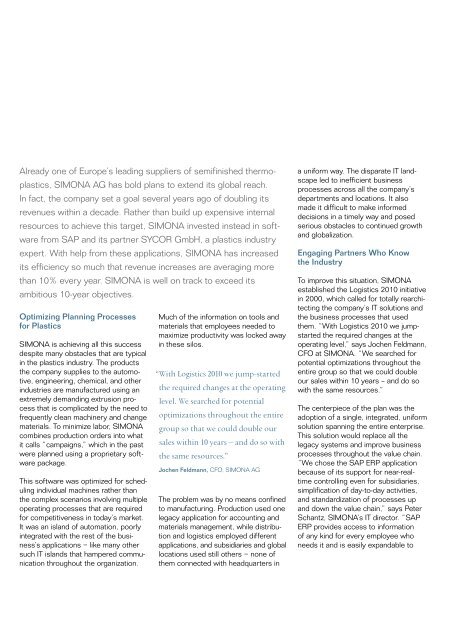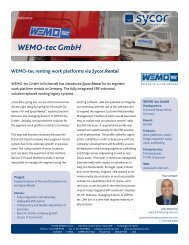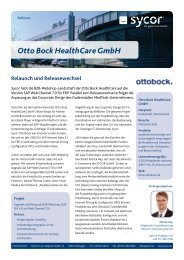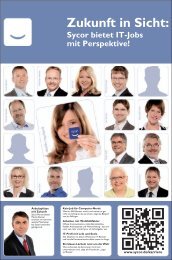see reference report (PDF 3,7 MB) - Sycor GmbH
see reference report (PDF 3,7 MB) - Sycor GmbH
see reference report (PDF 3,7 MB) - Sycor GmbH
You also want an ePaper? Increase the reach of your titles
YUMPU automatically turns print PDFs into web optimized ePapers that Google loves.
Already one of Europe’s leading suppliers of semifinished thermoplastics,<br />
SiMOnA AG has bold plans to extend its global reach.<br />
in fact, the company set a goal several years ago of doubling its<br />
revenues within a decade. Rather than build up expensive internal<br />
resources to achieve this target, SiMOnA invested instead in software<br />
from SAP and its partner SYCOR <strong>GmbH</strong>, a plastics industry<br />
expert. with help from these applications, SiMOnA has increased<br />
its efficiency so much that revenue increases are averaging more<br />
than 10% every year. SiMOnA is well on track to exceed its<br />
ambitious 10-year objectives.<br />
Optimizing Planning Processes<br />
for Plastics<br />
SiMOnA is achieving all this success<br />
despite many obstacles that are typical<br />
in the plastics industry. the products<br />
the company supplies to the automotive,<br />
engineering, chemical, and other<br />
industries are manufactured using an<br />
extremely demanding extrusion process<br />
that is complicated by the need to<br />
frequently clean machinery and change<br />
materials. to minimize labor, SiMOnA<br />
combines production orders into what<br />
it calls “campaigns,” which in the past<br />
were planned using a proprietary software<br />
package.<br />
this software was optimized for scheduling<br />
individual machines rather than<br />
the complex scenarios involving multiple<br />
operating processes that are required<br />
for competitiveness in today’s market.<br />
it was an island of automation, poorly<br />
integrated with the rest of the business’s<br />
applications − like many other<br />
such it islands that hampered communication<br />
throughout the organization.<br />
Much of the information on tools and<br />
materials that employees needed to<br />
maximize productivity was locked away<br />
in these silos.<br />
“With Logistics 2010 we jump-started<br />
the required changes at the operating<br />
level. We searched for potential<br />
optimizations throughout the entire<br />
group so that we could double our<br />
sales within 10 years – and do so with<br />
the same resources.”<br />
Jochen Feldmann, CfO, SiMOnA AG<br />
the problem was by no means confined<br />
to manufacturing. Production used one<br />
legacy application for accounting and<br />
materials management, while distribution<br />
and logistics employed different<br />
applications, and subsidiaries and global<br />
locations used still others − none of<br />
them connected with headquarters in<br />
a uniform way. the disparate it landscape<br />
led to inefficient business<br />
processes across all the company’s<br />
departments and locations. it also<br />
made it difficult to make informed<br />
decisions in a timely way and posed<br />
serious obstacles to continued growth<br />
and globalization.<br />
Engaging Partners Who Know<br />
the Industry<br />
to improve this situation, SiMOnA<br />
established the logistics 2010 initiative<br />
in 2000, which called for totally rearchitecting<br />
the company’s it solutions and<br />
the business processes that used<br />
them. “with logistics 2010 we jumpstarted<br />
the required changes at the<br />
operating level,” says Jochen feldmann,<br />
CfO at SiMOnA. “we searched for<br />
potential optimizations throughout the<br />
entire group so that we could double<br />
our sales within 10 years – and do so<br />
with the same resources.”<br />
the centerpiece of the plan was the<br />
adoption of a single, integrated, uniform<br />
solution spanning the entire enterprise.<br />
this solution would replace all the<br />
legacy systems and improve business<br />
processes throughout the value chain.<br />
“we chose the SAP ERP application<br />
because of its support for near-realtime<br />
controlling even for subsidiaries,<br />
simplification of day-to-day activities,<br />
and standardization of processes up<br />
and down the value chain,” says Peter<br />
Schantz, SiMOnA’s it director. “SAP<br />
ERP provides access to information<br />
of any kind for every employee who<br />
needs it and is easily expandable to








